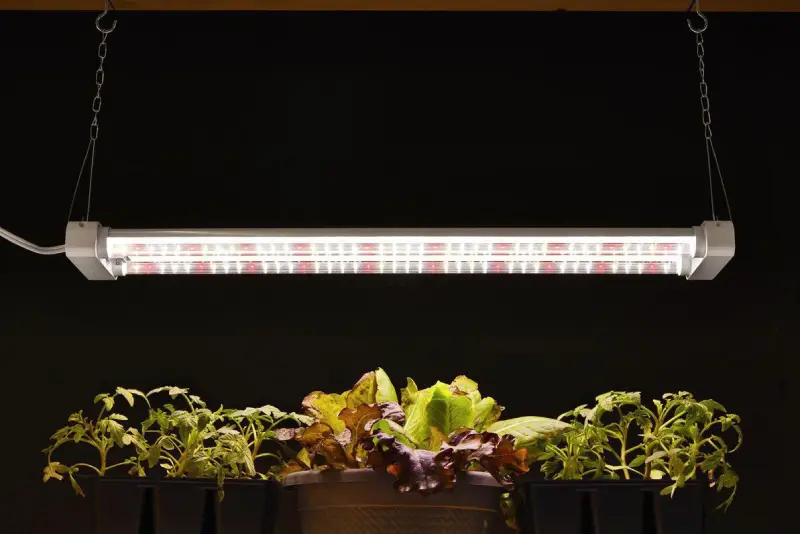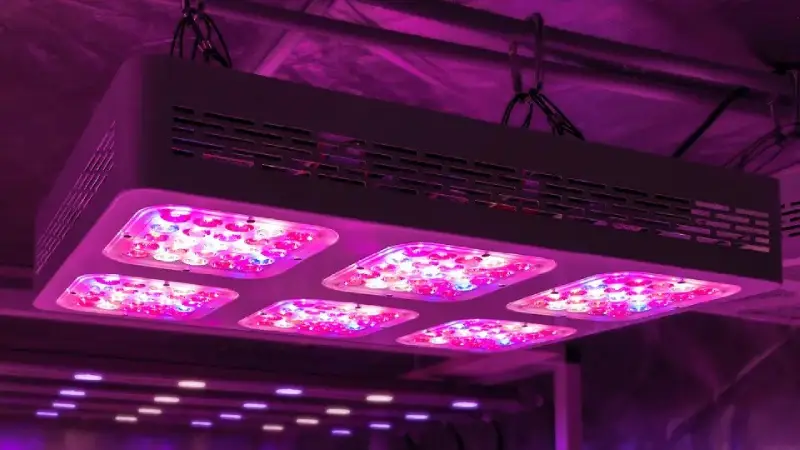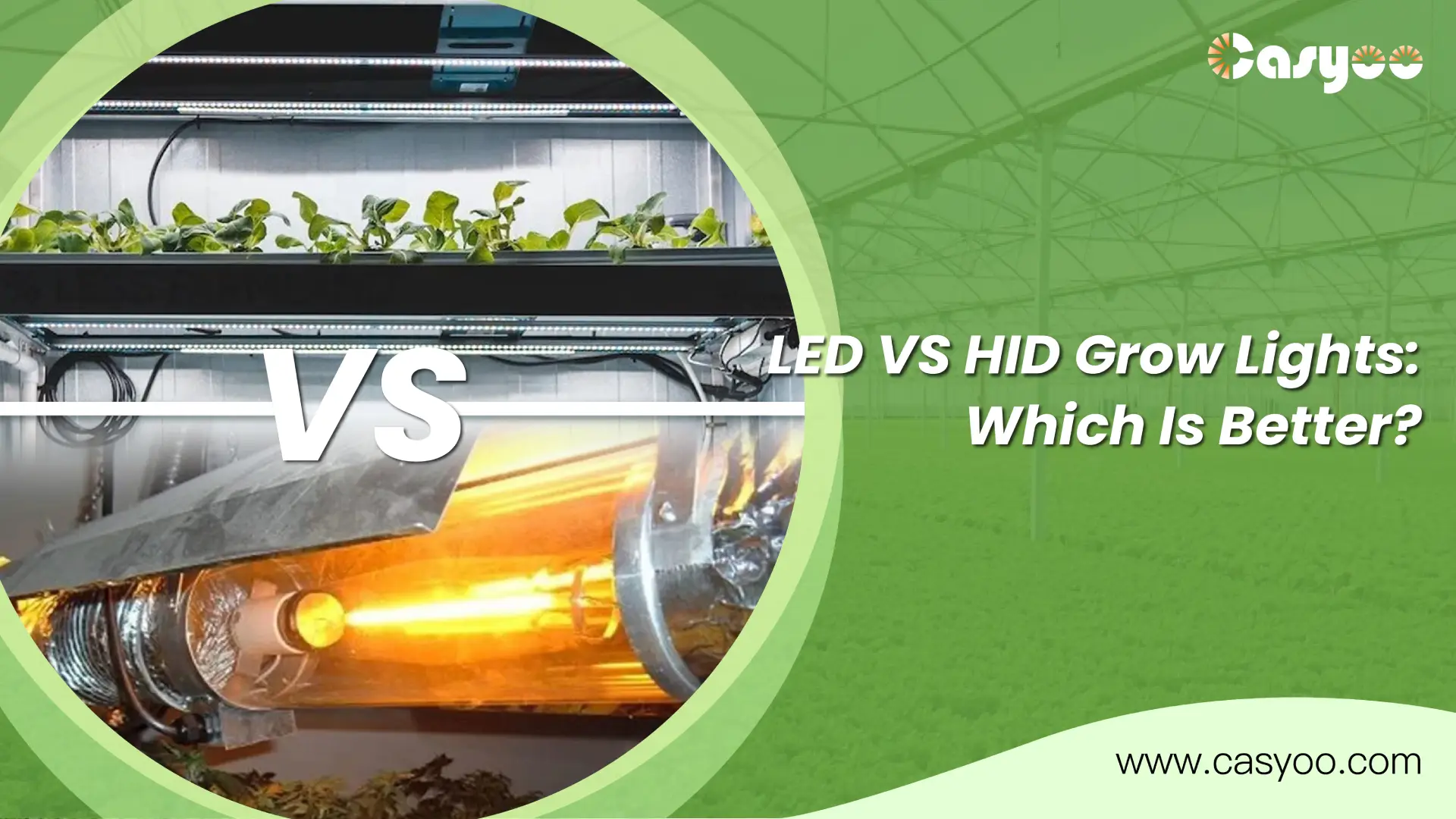There has been a constant debate among growers for years about LED VS HID grow lights. Now that LED technology has advanced and LED grow lights are constantly being updated, it’s time to discuss whether LED or HID grow lights are better for your plants.
What are LED grow lights?

LED grow lights use LED technology to produce specific wavelengths to help plants grow. Traditional LED grow lights simply combine red and blue wavelengths. But the purple light they emit is unpleasant to the eyes. Modern LED grow lights emit white light because they contain the entire spectrum. They are called full-spectrum grow lights. LED lights are known for their longer service life, and emit less heat than HID ones.
Advantages of LED grow lights

Run cooler
LED grow lights emit less heat than HIDs. HIDs are more efficient the hotter they burn, while LEDs are more efficient as they cool. Excess heat in a grow room increases humidity and condensation, which reduces airflow to your plants. Since indoor growers often face the risk of overheating their grow rooms when using HID grow lights, LEDs are more recommended. When temperatures are cooler, LED grow lights produce more photons per watt.
While LED grow lights already run cooler than HIDs, some models also include built-in cooling fans. These fans increase the energy efficiency of your grow lights and reduce operating costs. Additionally, since LED chips degrade faster in hotter conditions, a built-in fan can extend their lifespan.
Easier to maintain
MH bulbs typically last around 10,000 hours and HPS bulbs typically last 18,000 hours. A high-quality LED light can last between 50,000 and 100,000 hours. You don’t need to change them frequently.
Another low-maintenance feature of LED grow lights is that they have no reflectors that need to be cleaned and replaced. There is no need to replace the ballast for LED grow lights. In contrast, the ballast in HID lights needs to be changed every 3-4 years.
Last longer
Many manufacturers rate their LED grow lights to have a lifespan of 50,000 hours. Some last longer. In addition to a longer lifespan, LED grow light lumens depreciate less. HIDs tend to get darker with use, meaning growers may need to replace them sooner.
Easy to use
LED grow lights are often touted as all-in-one packages where you just need to plug them. Traditional grow lights require many components. In addition to the ballast, you will also need to purchase a reflector, individual and replacement bulbs, and a timer. LEDs do not require a reflector, have a built-in timer, and do not require any separate bulbs unless you are retrofitting HID lights.
The built-in cooling fan is also more user-friendly. If you are using a HID, you will need to divert some airflow to cool the light. Finally, since some LED lights have adjustable spectrum settings, you can change the spectrum depending on the growth stage of your plants.
Have custom functions
Since LED grow lights contain individual single-color diodes, turning some of the diodes on and off can change the overall output color. For lights with spectrum control, the app or remote lets you switch from full spectrum to vegetative or flowering settings as needed. In addition to adjusting the color spectrum, you can dim the fixtures or set a timer. Through the app, you can even control them remotely.
Disadvantages of LED grow lights
Higher upfront costs
From energy consumption, lifespan, etc., LED lights are superior to HID lights in many aspects, which means they are also more expensive. These costs can often be canceled out by long-term energy savings, but not all farmers have the budget to pay the upfront costs.
Low-quality LED grow lights have lower light intensity
While advanced LED lights can now compete with HID ones in terms of light output, many lower-quality LEDs cannot. You may need to adjust the height of your LEDs to ensure your plants are getting enough light.
Need to adjust the height
A lot of space is required between the LED grow lights and the plants for the best results. In the second half of the flowering period, small LED lights should be kept 45 cm or more away from the plants to avoid light burning the buds (even at very low temperatures, flower buds can be burned by too much light), while a powerful light will need to be 76cm or more away from the buds. If it is a very high-wattage LED, you may need to add heat-sinking equipment to keep the growing space cool.
What are HID grow lights?

HID grow lights are known for their impressive light output. They are constructed from gas-filled bulbs that have two electrodes. Bright light is produced as the arc moves between the electrodes and reacts with the gas inside the bulb.
The two main categories of HID lights are metal halide (MH) and high-pressure sodium (HPS). MH lamps produce blue light and are best used during the vegetative phase of the plant growth cycle. HPS bulbs produce a more golden color and are best suited for the blooming phase.
Advantages of HID grow lights
Have lower upfront costs
HID lights are typically cheaper than LED ones.
Keep your space warm in cold environments
If your plants are growing in a cold environment, then you will need supplemental heat. Because too cold is not conducive to plant growth. If you use a HID light, it can generate enough heat to increase your overall growth efficiency. This is when you need a HID grow light that runs at a much higher temperature than LEDs to keep your space warm. And you don’t need to buy supplement expensive heaters.
Disadvantages of HID grow lights
Emit more heat
HID grow lights can become very hot over time and produce a large amount of heat radiation. Since heat is concentrated and the light bulb is covered in a lampshade, cooling measures must be taken to prevent heat from dissipating to the plants and preventing the ambient temperature of the grow room from rising. This is especially important for lights with a power of more than 250W.
Require additional settings
Due to the heat mentioned above, most growers will use an exhaust fan with ducts to remove heat.
Not very energy-efficient
They require much more watts than LEDs to generate the same amount of light, and they also produce excess heat. To control heat, growers often need to spend additional money on cooling.
Do not integrate with vertical racks
Vertical shelves allow for the smallest distance between plants and the planting tray above. HID lights are not suitable for this type of setup due to their excessive heat and bulky design. Their operating expenses are more costly, and HID fixtures require bulb replacement every 6 to 12 months, or operators will suffer reduced yields and product quality.
LED VS HID Grow Lights: Final thoughts
Generally speaking, LED grow lights are more energy efficient and emit less heat than HID ones, making them easier to use and manage in a grow room. LED lights last longer, produce less glare, and reduce eye fatigue.
HID lights are more widely available and cheaper than LED lights. However, HID lights require more ventilation and generate more heat, which increases the cost of cooling and ventilation systems. In summary, the choice between LED and HID grow lights will depend on the grower’s specific needs and budget. For more information about LEDs, check out our website.





